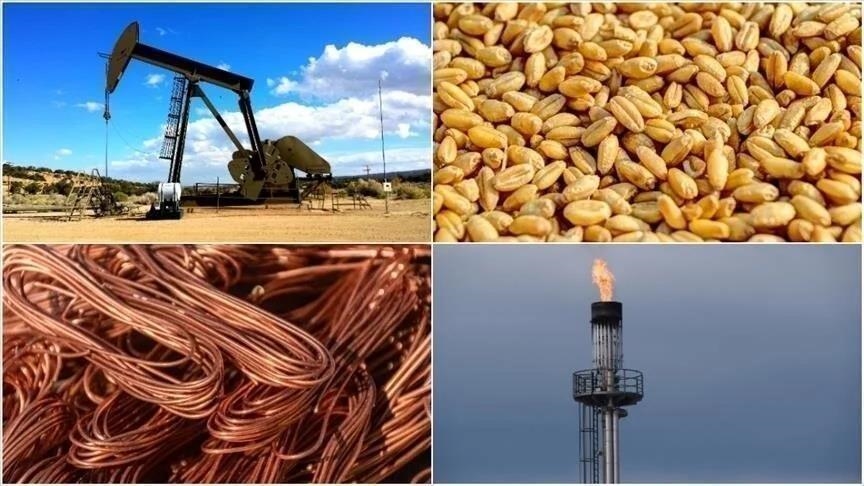ISTANBUL
Commodity prices were mixed last week amid ongoing geopolitical risks around the world and political uncertainties in South Korea.
Rising tensions in the Middle East and Asia impacted the markets.
Israel’s attacks on Syria increased following the intensifying clashes on Nov. 27, at the same time as the 61-year-old Ba’athist regime fell on Dec. 7.
The Taiwanese Ministry of National Defense said on X that it spotted aircraft and vessels from the Chinese People’s Liberation Army (PLA) crossing the Taiwan Strait on Monday.
Taiwanese President Lai Ching-te’s visit to the Pacific islands and his stops in Hawaii and Guam, both US-controlled, was met with criticism from China.
Mao Ning, spokeswoman for the Chinese foreign affairs ministry, said in a statement on Monday that the country will “firmly defend its national sovereignty and territorial integrity,” noting that “Taiwan is an inalienable part of China’s territory.”
Meanwhile, the US consumer price index (CPI) climbed 0.3% month-on-month and 2.7% on an annual basis within expectations, while the country’s producer price index (PPI) increased 0.4% on a monthly basis and 3% year-on-year, surpassing expectations.
The US Dollar Index rose nearly 1% to 106.9 last week.
Despite the increase in the CPI and the PPI fueling hopes that inflation is going down, President-elect Donald Trump’s additional tariff promises on the US’ major trade partners, especially on China, strengthen the estimates that the Fed may cut its policy rate slower than expected.
Meanwhile, China’s annual Central Economic Work Conference concluded last week. Chinese officials stated that the upward trend in the country’s economy has not changed, despite the negative impacts of external conditions and many issues still plaguing the economy.
As for gold, US-based investment bank Goldman Sachs reported that gold prices could exceed $3,000 by the end of 2025 despite the strong dollar due to the expected rate cuts by the Fed and the continuing gold purchases by central banks.
German industrial firm Heraeus said in a recent report that the demand for gold will increase with the possibility of central banks lowering interest rates and the dollar weakening, which could push gold prices to record highs by next year, estimating it to hover around $2,450 to $2,950 per ounce next year, while silver is expected to increase and the platinum market to run a deficit.
Canadian metal recycler Cyclic Metals said it will supply at least 10,000 metric tons of recycled copper to Swiss miner Glencore, while Swedish metal miner Boliden announced it will acquire Canadian miner Lundin Mining’s Swedish and Portuguese mines for $1.45 billion.
Last week, aluminum rose 0.7%, while lead fell 2.5%, nickel 0.8%, and zinc 1.3%. Copper followed a flat course.
As for the energy group, the International Energy Agency (IEA) reported that global oil production increased by about 130,000 per day month-on-month in November to 103.4 million barrels. The crude oil supply of OPEC countries increased 180,000 barrels per day to 27.2 million barrels at the same time.
The global oil demand is expected to increase by a little over 1 million barrels per day this year to 103.9 million barrels.
The price of Brent crude oil climbed 0.1% and natural gas 8.8% last week.
Meanwhile, Russia has reportedly halted wheat shipments to Syria due to uncertainties over the new government and delayed payment.
The Grain Industry Association of Western Australia upwardly revised its wheat crop estimates by 5%.
The US Department of Agriculture (USDA) reported that world rice production is estimated to have increased by 3.37 million tons month-on-month to 533.8 million tons, and the end-of-period stock estimates climbed 460,000 tons versus the previous season to 182.6 million tons.
The rice production estimates of the UN’s Food and Agriculture Organization (FAO) fell by 100,000 tons month-on-month to 538.8 million tons, while the end-of-period stocks are estimated to have dropped by 900,000 tons to 204.5 million tons.
Last week, the pound price of wheat fell 0.9%, while corn climbed 0.5%, soybeans 0.2%, and rice 0.5%.
Meanwhile, Brazilian coffee producers, including Dutch JDE Peet’s, plan to raise local prices in early 2025 due to unfavorable weather conditions.
Global coffee prices rose about 80% so far this year, led by droughts in Brazil and Vietnam, while JDE Peet’s is expected to raise prices by an average of 30%. Coffee price increases are expected to affect international consumers by the end of March 2025.
At the same time, the ton price of cocoa ended last week with a surge of 14.7%, close to an all-time high, while the pound price of sugar rose 5% and coffee fell 3.7%.

